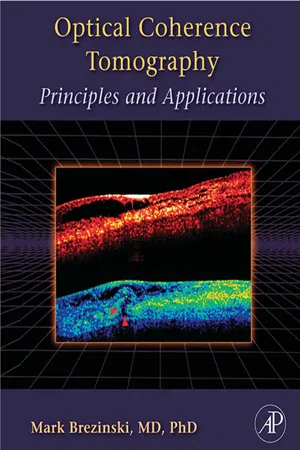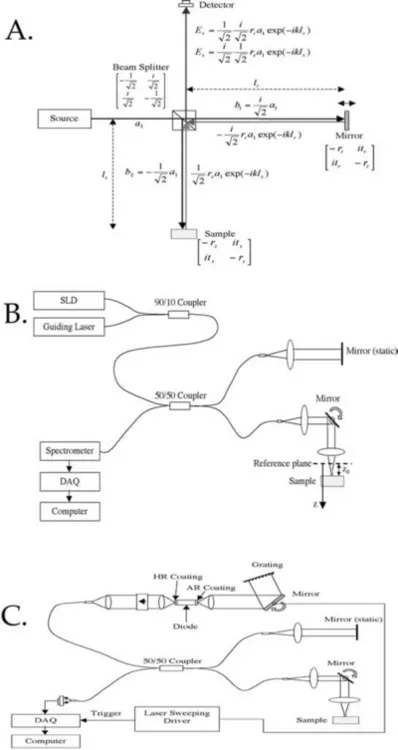
This is a test
- 480 pages
- English
- ePUB (mobile friendly)
- Available on iOS & Android
eBook - ePub
Book details
Book preview
Table of contents
Citations
About This Book
Optical Coherence Tomography gives a broad treatment of the subject which will include 1)the optics, science, and physics needed to understand the technology 2) a description of applications with a critical look at how the technology will successfully address actual clinical need, and 3) a discussion of delivery of OCT to the patient, FDA approval and comparisons with available competing technologies.
The required mathematical rigor will be present where needed but be presented in such a way that it will not prevent non-scientists and non-engineers from gaining a basic understanding of OCT and the applications as well as the issues of bringing the technology to the market.
- Optical Coherence Tomography is a new medical high-resolution imaging technology which offers distinct advantages over current medical imaging technologies and is attracting a large number of researchers.
- Provides non-scientists and non-engineers basic understanding of Optical Coherence Tomography applications and issues.
Frequently asked questions
At the moment all of our mobile-responsive ePub books are available to download via the app. Most of our PDFs are also available to download and we're working on making the final remaining ones downloadable now. Learn more here.
Both plans give you full access to the library and all of Perlego’s features. The only differences are the price and subscription period: With the annual plan you’ll save around 30% compared to 12 months on the monthly plan.
We are an online textbook subscription service, where you can get access to an entire online library for less than the price of a single book per month. With over 1 million books across 1000+ topics, we’ve got you covered! Learn more here.
Look out for the read-aloud symbol on your next book to see if you can listen to it. The read-aloud tool reads text aloud for you, highlighting the text as it is being read. You can pause it, speed it up and slow it down. Learn more here.
Yes, you can access Optical Coherence Tomography by Mark E. Brezinski in PDF and/or ePUB format, as well as other popular books in Ciencias biológicas & Biotecnología. We have over one million books available in our catalogue for you to explore.
Information
Topic
Ciencias biológicasSubtopic
BiotecnologíaSECTION II
5
OPTICAL COHERENCE TOMOGRAPHY THEORY
Chapter Contents
5.1 General
5.2 Time Domain OCT (TD-OCT)
5.2.1 Interferometry with a Monochromatic Source
5.2.2 Low Coherence Interferometry with OCT
5.2.3 Determination of Axial Resolution
5.2.4 Transfer Function
5.3 Dispersion
5.4 Lateral Resolution
5.4.1 Light Beam
5.4.2 Paraxial Wave Equation
5.4.3 Relationship between the Paraboloidal and Gaussian Wave
5.4.4 The Gaussian Wave
5.4.5 Properties of a Gaussian Wave
5.4.6 Important Points of a Gaussian Beam Relevant to OCT
5.4.7 Speckle
5.5 Spectral Radar or Fourier Domain OCT (FD-OCT)
5.6 Swept Source (SS-OCT)
5.6.1 The Resolution
References
Bibliography
Appendix 5-1
5.1 GENERAL
This chapter examines the major physical principles behind optical coherence tomography (OCT) imaging. These principles will be derived in considerable detail but for those only interested in the final results, skip the intermediate steps. The extensive derivations are provided to emphasize assumptions and approximations made so that the limitations of mathematical relationships presented in the literature can be understood. They are also provided for those in training who often find equations in the literature whose origins are not obvious.
Time domain OCT (TD-OCT) with a changing optical group delay in the reference arm will be examined first focusing on mechanisms generating high axial resolutions. It will initially be described in terms of the axial point spread function (PSF) and later in terms of the transfer function, as both are used in the literature. Dispersion and principles determining lateral resolution will then be discussed. Finally, this chapter concludes by examining spectral domain OCT (SD-OCT), which has recently generated considerable attention. Other aspects of the technology, such as signal to noise ratio (SNR) and polarization properties, will be discussed in later chapters. Throughout, the focus will be on the physics and application of OCT, not on details relevant to constructing the device.
OCT is analogous to ultrasound, measuring the backreflection intensity of infrared light rather than sound. However, unlike ultrasound, the backreflection intensity cannot be measured electronically due to the high speed associated with the propagation of light. Therefore, a technique known as low coherence interferometry is used. OCT requires an interferometer and will be described here with a Michelson interferometer, shown inFigure 5.1, the most common embodiment and similar to that in Chapter 4. In TD-OCT, light from the source is divided evenly by the beam splitter, half toward the sample and half toward a moving mirror (Figure 5.1A). Light reflects off the mirror and from within the sample. The light is recombined by the beam splitter and directed at the detector. If the pathlengths match to within a coherence length, interference will occur. OCT measures the intensity of interference and uses it to represent backreflection intensity. Figure 5.1B and C are schematics for Fourier domain (FD-OCT) and swept source (SS-OCT), respectively. They will be discussed later in the chapter.

Figure 5.1 Image A is a schematic of time domain (TD-OCT). The embodiment includes a moving mirror in the reference arm. The schematic includes alterations in phase due to beam splitters and mirrors as well as reductions in intensities at different stages. Images B and C are schematics of Fourier domain (FD-OCT) and swept source (SS-OCT), respectively.
5.2 TIME DOMAIN OCT (TD-OCT)
5.2.1 Interferometry with a Monochromatic Source
The performance of OCT imaging can be described mathematically using an approach similar to that used in Chapter 4, starting initially with a monochromatic wave. However, in this section, the interferometer will be described in more detail, in terms of the electrical field rather than the intensity, so that both amplitude and phase components can be followed. The mathematical manipulations are slightly more complicated since now the phase is introduced through the imaginary
term i and negative signs, where we will see that the former represents a 180-degree change in phase while the latter is a 90-degree phase change. In subsequent sections we will generally ignore these phase relationships for simplicity, but the reader can refer back to this section when necessary although these particular phase changes. We will initially begin with a monochromatic complex plane wave of the form1:

Once again, k = 2π/λ.
In the interferometer, beam splitters and mirrors are represented by the general matrix:

where r is the reflectivity and t is the transmission. The negative sign represents a 180-degree phase shift while i is a 90-degree phase shift. For the 50/50 beam splitter the ABCD matrix is:

The two light beams entering each arm are represented by:

The two light beams from the beam splitter are directed onto mirrors in t...
Table of contents
- Cover image
- Title page
- Table of Contents
- Copyright
- ABOUT THE AUTHOR
- PREFACE
- ACKNOWLEDGMENTS
- SECTION I
- SECTION II
- SECTION III
- INDEX